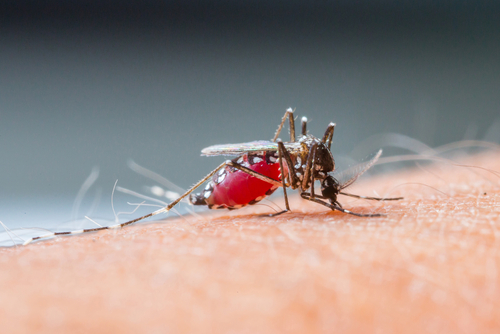 Big Data vs. tiny mosquitoes.[/caption] IBM is collaborating with Johns Hopkins University and the University of California, San Francisco on a data-analytics initiative that could help curb outbreaks of insect-borne diseases such as dengue fever and malaria. Researchers have spent years building models to track the spread of disease, hampered along the way by the usual issues that come with crunching massive amounts of data: lack of computing power and storage, missing and incomplete datasets, and the sheer amount of time it takes to design a working prototype. A fast-moving epidemic can further aggravate these problems. “Public health officials can’t afford to act on speculation during an epidemic. They need accurate and timely access to data to see what the potential spread of a disease might be for a given geographic region over a period of time,” James Kaufman, Public Health Manager of IBM Research, wrote in a statement. ‘The scientific and research communities are collaborating to lead a new age of science-based, data-centric disease modeling to protect the health of people.” By understanding how and why diseases spread, he added, “we can identify those regions most susceptible to emerging disease, inform public health, and allow them to focus on specific interventions in locations where they can have the greatest impact.” But how does the scientific community reach a better understanding? Researchers at IBM and the two aforementioned universities are refining new disease models based on the Spatio Temporal Epidemiological Modeler (STEM), an open-source modeling application that allows them to merge everything from disease-path algorithms to population analytics. The platform allows users to look at particularly fine-grained variables, such as temperature and precipitation variation, that can nonetheless have a huge effect on insect population, and layer that data atop existing models for more granular insight. (Efficient software, combined with ever-more-powerful hardware, also allows scientists to produce outputs more quickly.) “There are a lot of tacit assumptions out there about how changes in climate will impact the distribution of diseases like malaria. This work suggests that things probably are not so simple, a change that has a huge effect on malaria transmission in one place might not be as important somewhere else,” Justin Lessler, an assistant professor at the Johns Hopkins Bloomberg School of Public Health, wrote in a statement released by IBM. “One of the nice things about open source projects like STEM is that now whoever wants to can download the model and start tweaking it, seeing if their own data or assumptions fundamentally change the results.” STEM is free and available through the Eclipse Foundation. Image: smuay/Shutterstock.com
Big Data vs. tiny mosquitoes.[/caption] IBM is collaborating with Johns Hopkins University and the University of California, San Francisco on a data-analytics initiative that could help curb outbreaks of insect-borne diseases such as dengue fever and malaria. Researchers have spent years building models to track the spread of disease, hampered along the way by the usual issues that come with crunching massive amounts of data: lack of computing power and storage, missing and incomplete datasets, and the sheer amount of time it takes to design a working prototype. A fast-moving epidemic can further aggravate these problems. “Public health officials can’t afford to act on speculation during an epidemic. They need accurate and timely access to data to see what the potential spread of a disease might be for a given geographic region over a period of time,” James Kaufman, Public Health Manager of IBM Research, wrote in a statement. ‘The scientific and research communities are collaborating to lead a new age of science-based, data-centric disease modeling to protect the health of people.” By understanding how and why diseases spread, he added, “we can identify those regions most susceptible to emerging disease, inform public health, and allow them to focus on specific interventions in locations where they can have the greatest impact.” But how does the scientific community reach a better understanding? Researchers at IBM and the two aforementioned universities are refining new disease models based on the Spatio Temporal Epidemiological Modeler (STEM), an open-source modeling application that allows them to merge everything from disease-path algorithms to population analytics. The platform allows users to look at particularly fine-grained variables, such as temperature and precipitation variation, that can nonetheless have a huge effect on insect population, and layer that data atop existing models for more granular insight. (Efficient software, combined with ever-more-powerful hardware, also allows scientists to produce outputs more quickly.) “There are a lot of tacit assumptions out there about how changes in climate will impact the distribution of diseases like malaria. This work suggests that things probably are not so simple, a change that has a huge effect on malaria transmission in one place might not be as important somewhere else,” Justin Lessler, an assistant professor at the Johns Hopkins Bloomberg School of Public Health, wrote in a statement released by IBM. “One of the nice things about open source projects like STEM is that now whoever wants to can download the model and start tweaking it, seeing if their own data or assumptions fundamentally change the results.” STEM is free and available through the Eclipse Foundation. Image: smuay/Shutterstock.com How Open-Source Could Help Fight Malaria
[caption id="attachment_12751" align="aligncenter" width="500"]  Big Data vs. tiny mosquitoes.[/caption] IBM is collaborating with Johns Hopkins University and the University of California, San Francisco on a data-analytics initiative that could help curb outbreaks of insect-borne diseases such as dengue fever and malaria. Researchers have spent years building models to track the spread of disease, hampered along the way by the usual issues that come with crunching massive amounts of data: lack of computing power and storage, missing and incomplete datasets, and the sheer amount of time it takes to design a working prototype. A fast-moving epidemic can further aggravate these problems. “Public health officials can’t afford to act on speculation during an epidemic. They need accurate and timely access to data to see what the potential spread of a disease might be for a given geographic region over a period of time,” James Kaufman, Public Health Manager of IBM Research, wrote in a statement. ‘The scientific and research communities are collaborating to lead a new age of science-based, data-centric disease modeling to protect the health of people.” By understanding how and why diseases spread, he added, “we can identify those regions most susceptible to emerging disease, inform public health, and allow them to focus on specific interventions in locations where they can have the greatest impact.” But how does the scientific community reach a better understanding? Researchers at IBM and the two aforementioned universities are refining new disease models based on the Spatio Temporal Epidemiological Modeler (STEM), an open-source modeling application that allows them to merge everything from disease-path algorithms to population analytics. The platform allows users to look at particularly fine-grained variables, such as temperature and precipitation variation, that can nonetheless have a huge effect on insect population, and layer that data atop existing models for more granular insight. (Efficient software, combined with ever-more-powerful hardware, also allows scientists to produce outputs more quickly.) “There are a lot of tacit assumptions out there about how changes in climate will impact the distribution of diseases like malaria. This work suggests that things probably are not so simple, a change that has a huge effect on malaria transmission in one place might not be as important somewhere else,” Justin Lessler, an assistant professor at the Johns Hopkins Bloomberg School of Public Health, wrote in a statement released by IBM. “One of the nice things about open source projects like STEM is that now whoever wants to can download the model and start tweaking it, seeing if their own data or assumptions fundamentally change the results.” STEM is free and available through the Eclipse Foundation. Image: smuay/Shutterstock.com
Big Data vs. tiny mosquitoes.[/caption] IBM is collaborating with Johns Hopkins University and the University of California, San Francisco on a data-analytics initiative that could help curb outbreaks of insect-borne diseases such as dengue fever and malaria. Researchers have spent years building models to track the spread of disease, hampered along the way by the usual issues that come with crunching massive amounts of data: lack of computing power and storage, missing and incomplete datasets, and the sheer amount of time it takes to design a working prototype. A fast-moving epidemic can further aggravate these problems. “Public health officials can’t afford to act on speculation during an epidemic. They need accurate and timely access to data to see what the potential spread of a disease might be for a given geographic region over a period of time,” James Kaufman, Public Health Manager of IBM Research, wrote in a statement. ‘The scientific and research communities are collaborating to lead a new age of science-based, data-centric disease modeling to protect the health of people.” By understanding how and why diseases spread, he added, “we can identify those regions most susceptible to emerging disease, inform public health, and allow them to focus on specific interventions in locations where they can have the greatest impact.” But how does the scientific community reach a better understanding? Researchers at IBM and the two aforementioned universities are refining new disease models based on the Spatio Temporal Epidemiological Modeler (STEM), an open-source modeling application that allows them to merge everything from disease-path algorithms to population analytics. The platform allows users to look at particularly fine-grained variables, such as temperature and precipitation variation, that can nonetheless have a huge effect on insect population, and layer that data atop existing models for more granular insight. (Efficient software, combined with ever-more-powerful hardware, also allows scientists to produce outputs more quickly.) “There are a lot of tacit assumptions out there about how changes in climate will impact the distribution of diseases like malaria. This work suggests that things probably are not so simple, a change that has a huge effect on malaria transmission in one place might not be as important somewhere else,” Justin Lessler, an assistant professor at the Johns Hopkins Bloomberg School of Public Health, wrote in a statement released by IBM. “One of the nice things about open source projects like STEM is that now whoever wants to can download the model and start tweaking it, seeing if their own data or assumptions fundamentally change the results.” STEM is free and available through the Eclipse Foundation. Image: smuay/Shutterstock.com
 Big Data vs. tiny mosquitoes.[/caption] IBM is collaborating with Johns Hopkins University and the University of California, San Francisco on a data-analytics initiative that could help curb outbreaks of insect-borne diseases such as dengue fever and malaria. Researchers have spent years building models to track the spread of disease, hampered along the way by the usual issues that come with crunching massive amounts of data: lack of computing power and storage, missing and incomplete datasets, and the sheer amount of time it takes to design a working prototype. A fast-moving epidemic can further aggravate these problems. “Public health officials can’t afford to act on speculation during an epidemic. They need accurate and timely access to data to see what the potential spread of a disease might be for a given geographic region over a period of time,” James Kaufman, Public Health Manager of IBM Research, wrote in a statement. ‘The scientific and research communities are collaborating to lead a new age of science-based, data-centric disease modeling to protect the health of people.” By understanding how and why diseases spread, he added, “we can identify those regions most susceptible to emerging disease, inform public health, and allow them to focus on specific interventions in locations where they can have the greatest impact.” But how does the scientific community reach a better understanding? Researchers at IBM and the two aforementioned universities are refining new disease models based on the Spatio Temporal Epidemiological Modeler (STEM), an open-source modeling application that allows them to merge everything from disease-path algorithms to population analytics. The platform allows users to look at particularly fine-grained variables, such as temperature and precipitation variation, that can nonetheless have a huge effect on insect population, and layer that data atop existing models for more granular insight. (Efficient software, combined with ever-more-powerful hardware, also allows scientists to produce outputs more quickly.) “There are a lot of tacit assumptions out there about how changes in climate will impact the distribution of diseases like malaria. This work suggests that things probably are not so simple, a change that has a huge effect on malaria transmission in one place might not be as important somewhere else,” Justin Lessler, an assistant professor at the Johns Hopkins Bloomberg School of Public Health, wrote in a statement released by IBM. “One of the nice things about open source projects like STEM is that now whoever wants to can download the model and start tweaking it, seeing if their own data or assumptions fundamentally change the results.” STEM is free and available through the Eclipse Foundation. Image: smuay/Shutterstock.com
Big Data vs. tiny mosquitoes.[/caption] IBM is collaborating with Johns Hopkins University and the University of California, San Francisco on a data-analytics initiative that could help curb outbreaks of insect-borne diseases such as dengue fever and malaria. Researchers have spent years building models to track the spread of disease, hampered along the way by the usual issues that come with crunching massive amounts of data: lack of computing power and storage, missing and incomplete datasets, and the sheer amount of time it takes to design a working prototype. A fast-moving epidemic can further aggravate these problems. “Public health officials can’t afford to act on speculation during an epidemic. They need accurate and timely access to data to see what the potential spread of a disease might be for a given geographic region over a period of time,” James Kaufman, Public Health Manager of IBM Research, wrote in a statement. ‘The scientific and research communities are collaborating to lead a new age of science-based, data-centric disease modeling to protect the health of people.” By understanding how and why diseases spread, he added, “we can identify those regions most susceptible to emerging disease, inform public health, and allow them to focus on specific interventions in locations where they can have the greatest impact.” But how does the scientific community reach a better understanding? Researchers at IBM and the two aforementioned universities are refining new disease models based on the Spatio Temporal Epidemiological Modeler (STEM), an open-source modeling application that allows them to merge everything from disease-path algorithms to population analytics. The platform allows users to look at particularly fine-grained variables, such as temperature and precipitation variation, that can nonetheless have a huge effect on insect population, and layer that data atop existing models for more granular insight. (Efficient software, combined with ever-more-powerful hardware, also allows scientists to produce outputs more quickly.) “There are a lot of tacit assumptions out there about how changes in climate will impact the distribution of diseases like malaria. This work suggests that things probably are not so simple, a change that has a huge effect on malaria transmission in one place might not be as important somewhere else,” Justin Lessler, an assistant professor at the Johns Hopkins Bloomberg School of Public Health, wrote in a statement released by IBM. “One of the nice things about open source projects like STEM is that now whoever wants to can download the model and start tweaking it, seeing if their own data or assumptions fundamentally change the results.” STEM is free and available through the Eclipse Foundation. Image: smuay/Shutterstock.com 

